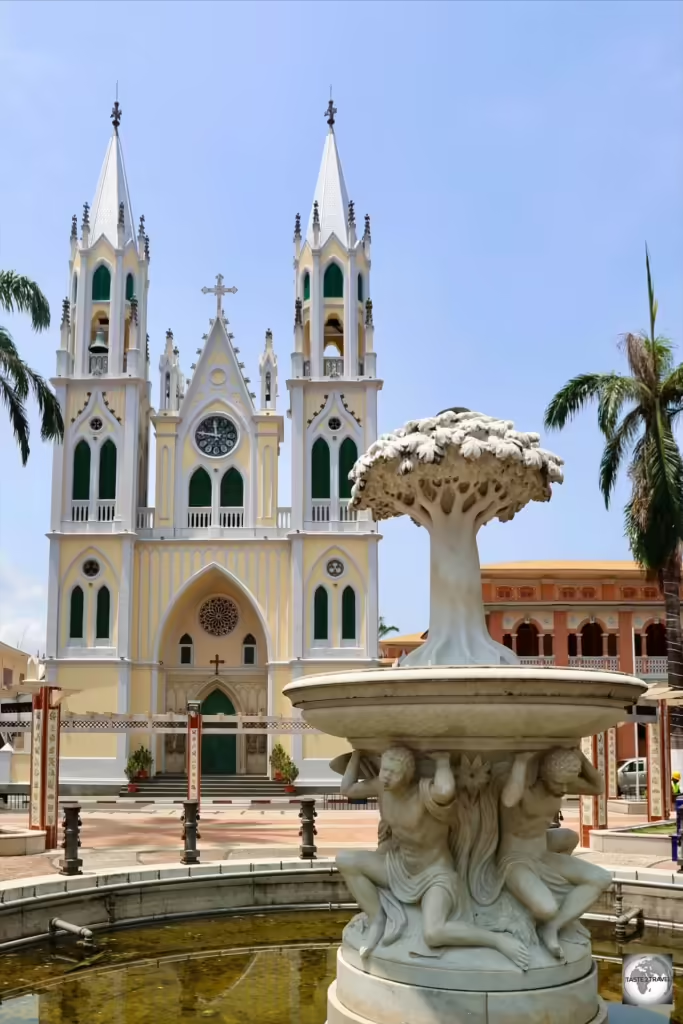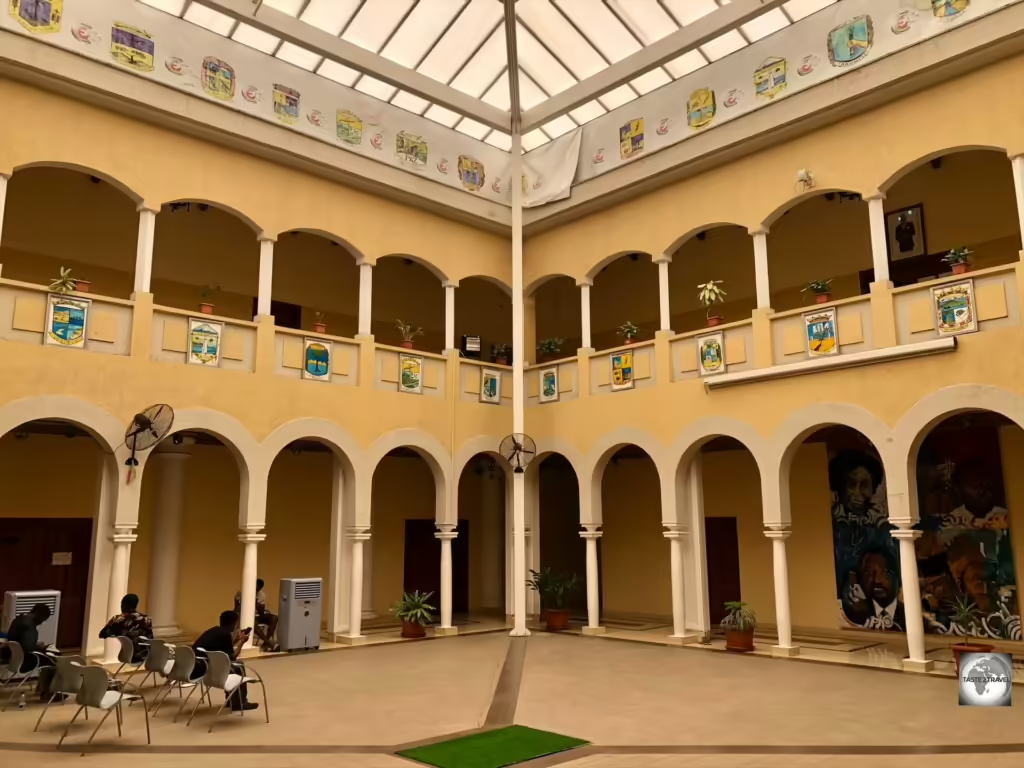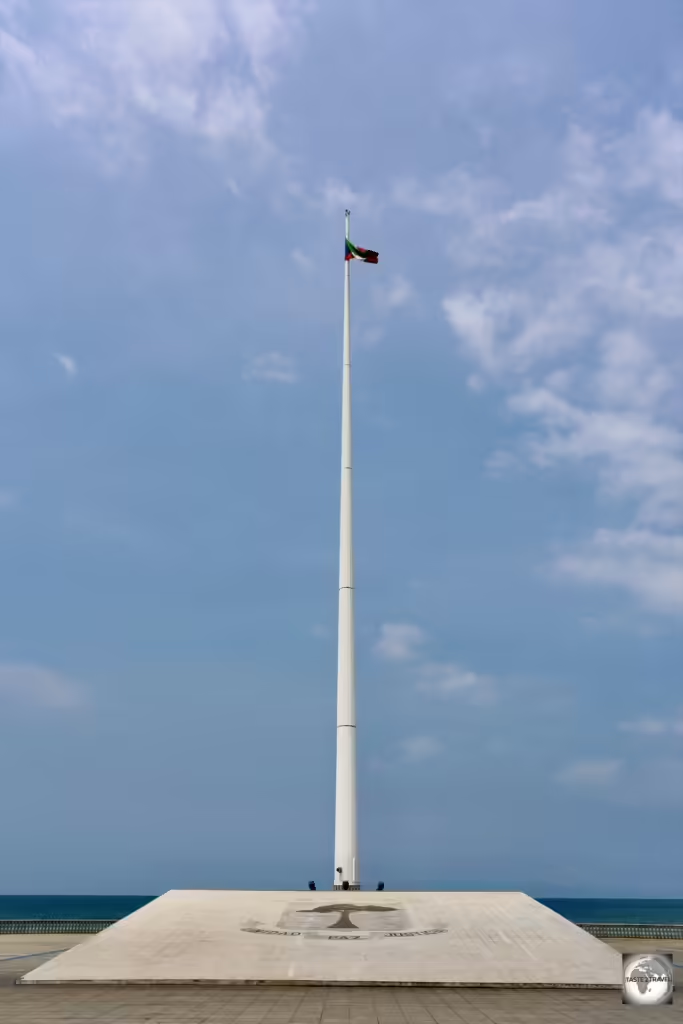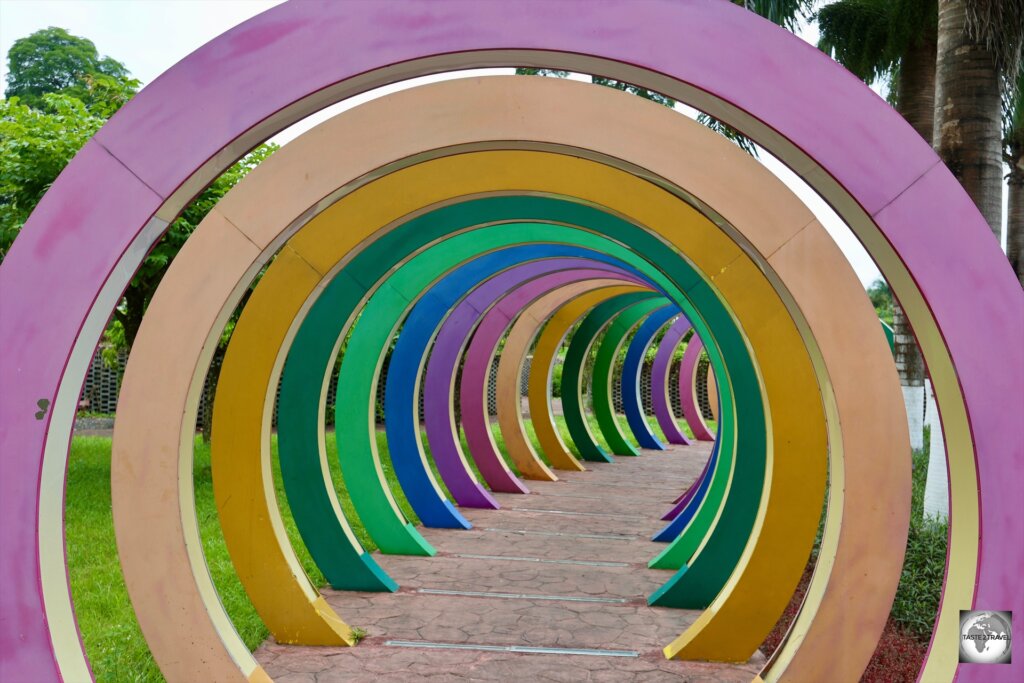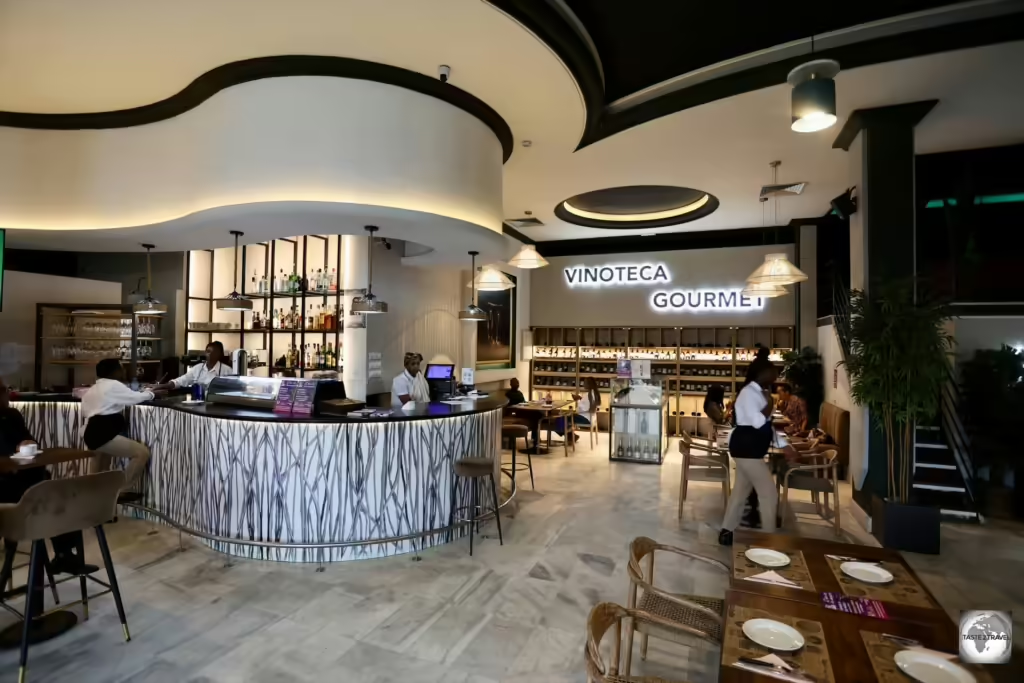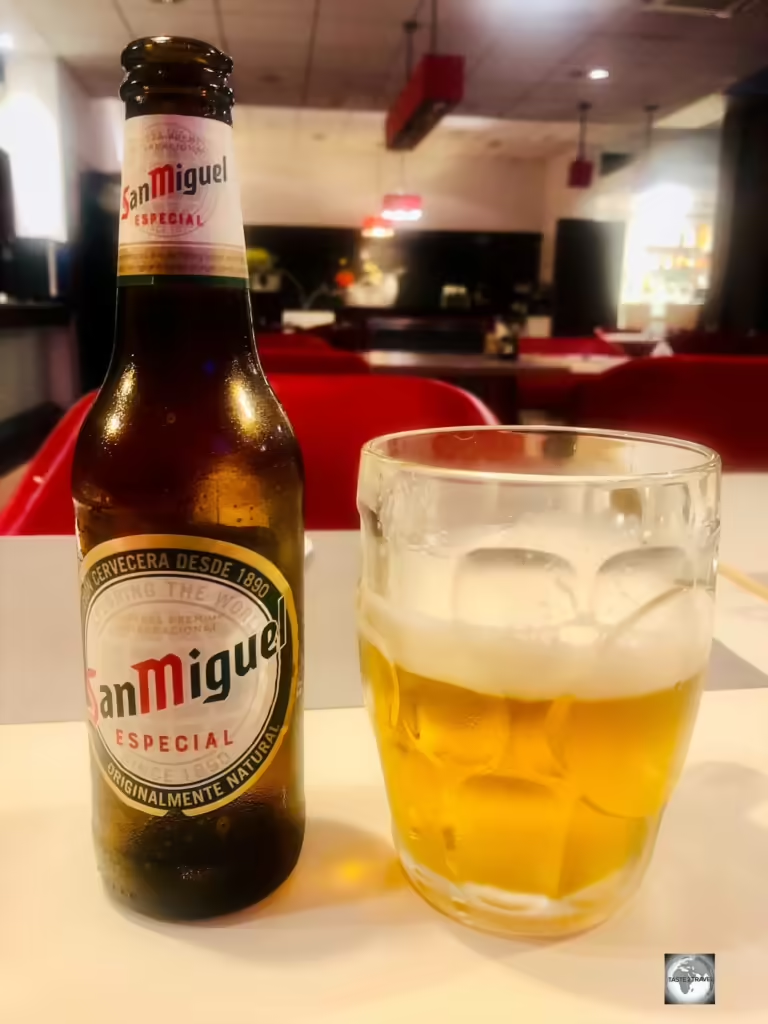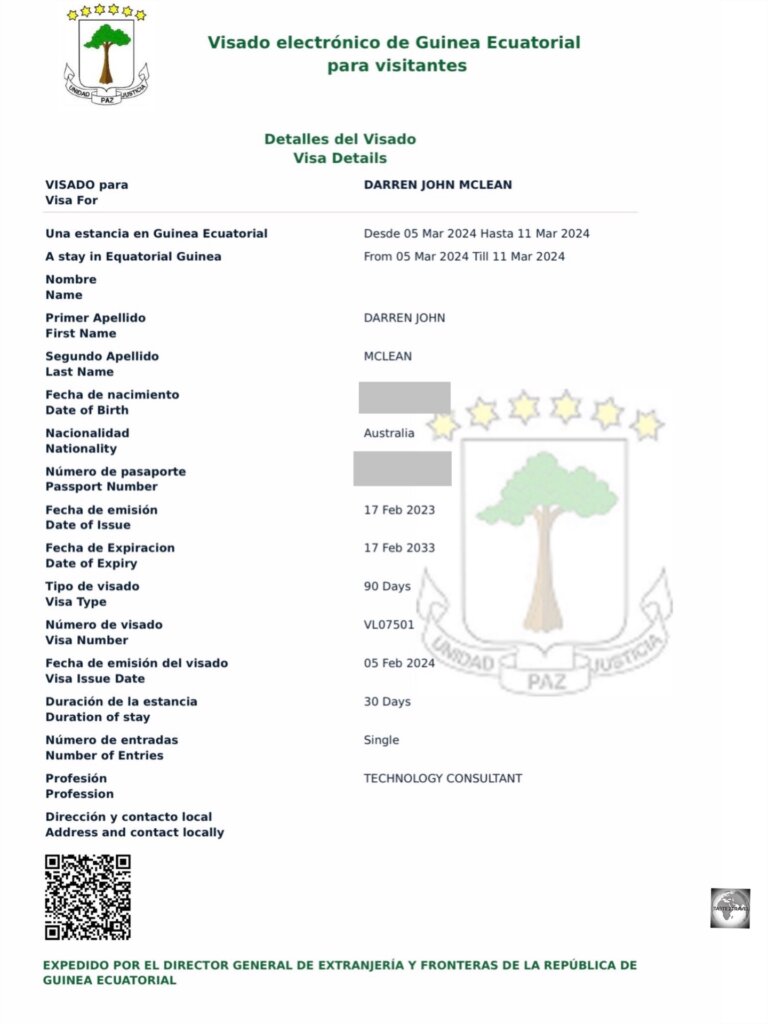Equatorial Guinea Travel Guide
This is an Equatorial Guinea Travel Guide from taste2travel.com
Date Visited: March 2024
Introduction
Nestled along the coastline of Central Africa, Equatorial Guinea awaits the adventurous traveller with its lush rainforests, vibrant culture, and captivating history.

Malabo National Park, a manicured garden in the capital city, features eight zones for visitors to discover.
Despite being one of Africa’s smallest countries, this hidden gem boasts an array of experiences waiting to be discovered.
While gaining a tourist visa was once difficult, a change in government policy, and the introduction of an eVisa process has made it easier than ever to visit this once isolated tropical jewel.
I fully explain the new eVisa process in the Visa Requirements section below.

Located on Bioko Island, Malabo is the capital of Equatorial Guinea.
This guide covers my stay in Malabo, the capital of Equatorial Guinea.
To travel outside the capital, visitors are required to apply for a Travel Authorisation which is issued by the Ministry of Tourism and takes 3-4 business days to process.
Local tour companies will arrange this permit for paying clients.

Finca Sampaka produces very fine chocolate, a short drive from downtown Malabo.
In a bid to diversify its economy away from declining oil revenues, Equatorial Guinea has now opened its doors to tourism.
Now is the opportune time to visit, before the hordes arrive!
Location
Malabo, Equatorial Guinea
Equatorial Guinea is situated on the west coast of Central Africa, bordered by Cameroon to the north and Gabon to the east and south.
Its unique location places it just north of the equator, giving the country its name.

A view of the port in Malabo, the capital of Equatorial Guinea.
The country consists of a mainland region known as Rio Muni, along with several small offshore islands.
The largest of these islands is Bioko, also known as Fernando Po, located about 40 kilometres (25 miles) off the coast of Cameroon. Bioko is home to the capital city, Malabo.
One unique geographical feature is that the Equator passes through the country, specifically through the island of Corisco, making Equatorial Guinea one of the few countries in the world to be bisected by this imaginary line.
Overall, Equatorial Guinea’s location provides it with a diverse range of ecosystems, from coastal mangroves to dense rainforests, making it a fascinating destination for those interested in exploring varied landscapes and biodiversity.
People

Artwork at the Equatorial Guinea Cultural Centre in Malabo.
The population of this small but culturally rich nation is a mix of different ethnic groups, each contributing to the country’s unique identity.
The country is home to several ethnic groups, with the Fang being the largest. The Fang people primarily inhabit the mainland region of Rio Muni.
Other major ethnic groups include the Bubi on Bioko Island, the Ndowe, the Bujeba, and the Annobonese on the island of Annobón.
Each group has its own traditions, languages, and cultural practices, enriching the country’s cultural landscape.
The official languages of Equatorial Guinea are Spanish, French, and Portuguese due to its colonial history.
However, there are also several indigenous languages spoken across the country. Fang, Bubi, and Igbo are among the most widely spoken native languages.

A view of the interior of Saint Elizabeth’s Cathedral, the main cathedral in Malabo.
Religion in Equatorial Guinea reflects its historical influences.
The majority of the population identifies as Christian, with Roman Catholicism being the predominant denomination.
However, there are also followers of indigenous beliefs and Islam, particularly among some of the ethnic groups.

The Equatoguinean Cultural Centre in Malabo promotes local arts and culture.
Despite its small size, Equatorial Guinea’s population is a testament to the richness and diversity of African cultures.
The people, with their strong sense of identity and community, contribute to the country’s colorful mosaic of traditions and customs.
Worth checking out is the Equatoguinean Cultural Centre, which is housed in a beautiful, yellow, colonial building on the main street in Malabo.
The centre promotes local arts and culture and is always full of students who take advantage of the free WiFi, which is available in the central atrium.
Flag

The flag of Equatorial Guinea.
The flag of Equatorial Guinea was adopted on October 12, 1968, upon gaining independence from Spain.
It consists of three horizontal bands of green, white, and red, with a blue triangle on the hoist side of the flag.
The green band symbolises the country’s natural resources, particularly its lush forests and vegetation. Green is also often associated with agriculture and the country’s hope for a prosperous future.
The white band represents peace and unity. It signifies the country’s aspirations for harmony among its diverse population and its commitment to peaceful coexistence.
The red band symbolises the sacrifices made for independence and the bloodshed of the country’s martyrs. Red is a common color in many African flags, often representing the struggles for freedom.
The blue triangle on the hoist side of the flag represents the sea, as Equatorial Guinea is a coastal nation. Blue is also a color associated with the ocean and maritime activities.

A tiny, barely visible, Equatorial Guinea flag, flying upon the tallest flagpole in Malabo at Plaza of Equatorial Guinea.
In the centre of the flag is the national coat of arms of Equatorial Guinea.
The coat of arms features a silk cotton tree (Ceiba pentandra), which is a symbol of national prosperity.
Above the tree, there are six yellow six-pointed stars, representing the country’s mainland and five islands.
Below the tree, there is a banner bearing the national motto “Unidad, Paz, Justicia” (Unity, Peace, Justice).
Currency
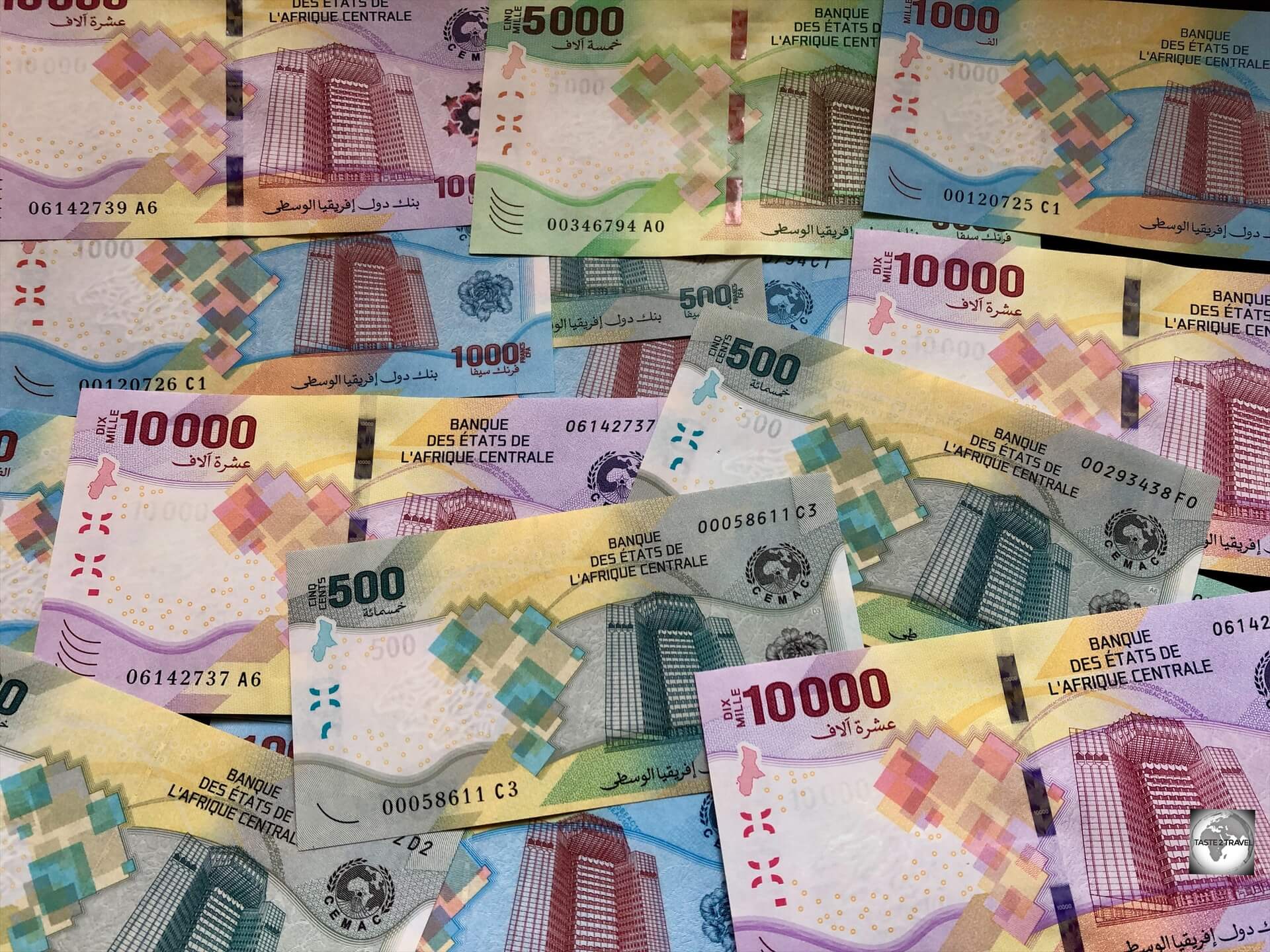
The currency of Equatorial Guinea is the Central African CFA franc, which is the official currency of six central African nations.
The currency of Equatorial Guinea is the Central African CFA franc, which has the international currency code of XAF.
This currency is used by six countries in the Central African region, including Equatorial Guinea, Cameroon, Chad, Central African Republic, Congo-Brazzaville, and Gabon.
The CFA franc is pegged to the Euro, with a fixed exchange rate, providing stability in international transactions.
Currently, €1 = 655.96 CFA francs.
This peg has meant that travel costs in all countries in the CFA zone are much higher than costs on the non-CFA countries.
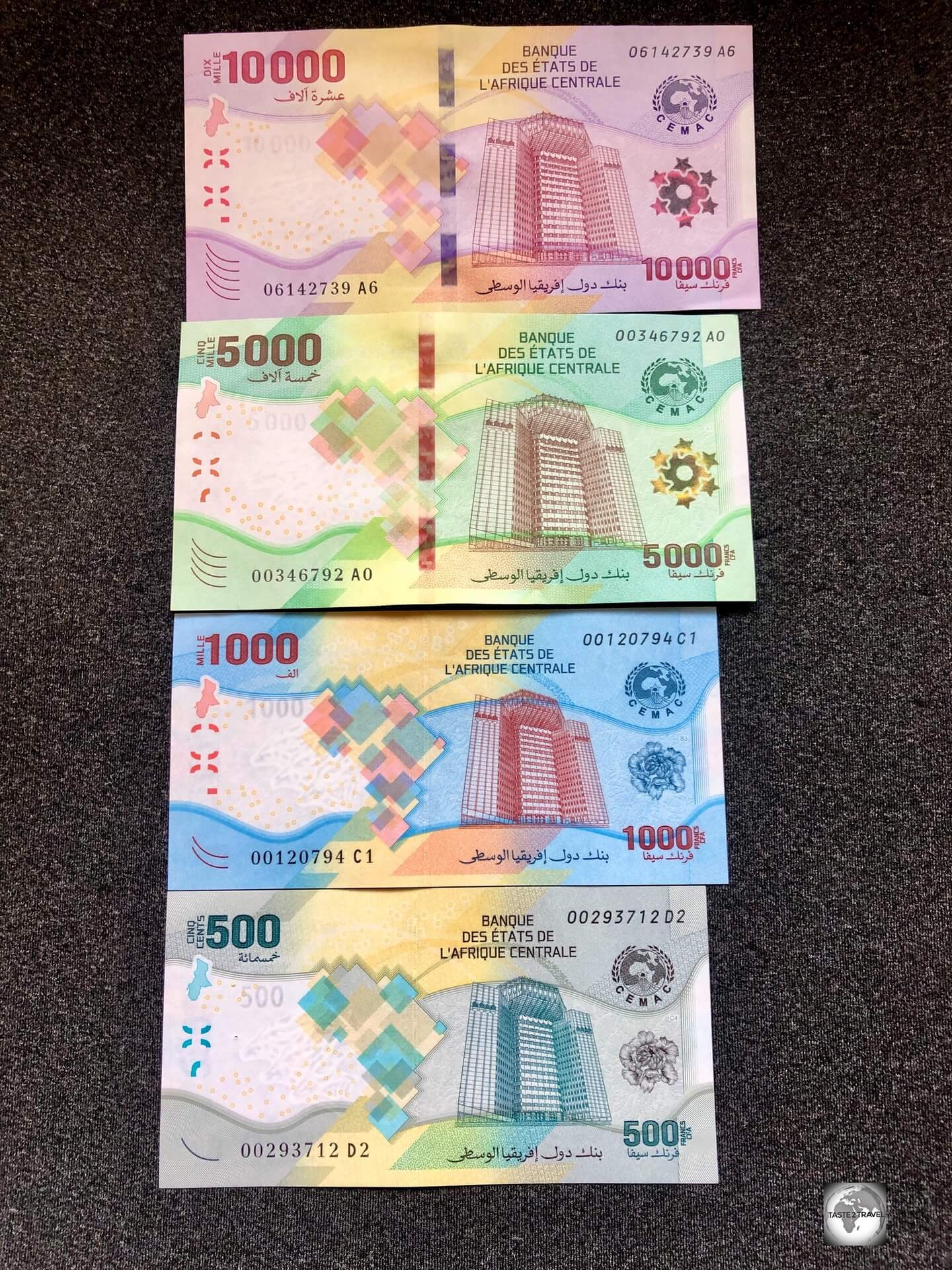
Almost a full set of (uncirculated) CFA franc banknotes – with the 2,000 missing!
Within Equatorial Guinea, the currency is issued and regulated by the Bank of Central African States (BEAC), which is the central bank for the Central African Economic and Monetary Community (CEMAC).
The bank is headquartered in Yaoundé, Cameroon, with the headquarters building featured on the front of all banknotes.
The CFA franc is denoted by the symbol “FCFA” or “XAF” and is available in both coins and banknotes.
Coins are available in denominations of 1, 2, 5, 10, 25, 50, 100, and 500 francs, while banknotes are issued in denominations of 500, 1,000, 2,000, 5,000, and 10,000 francs.
Banking Services
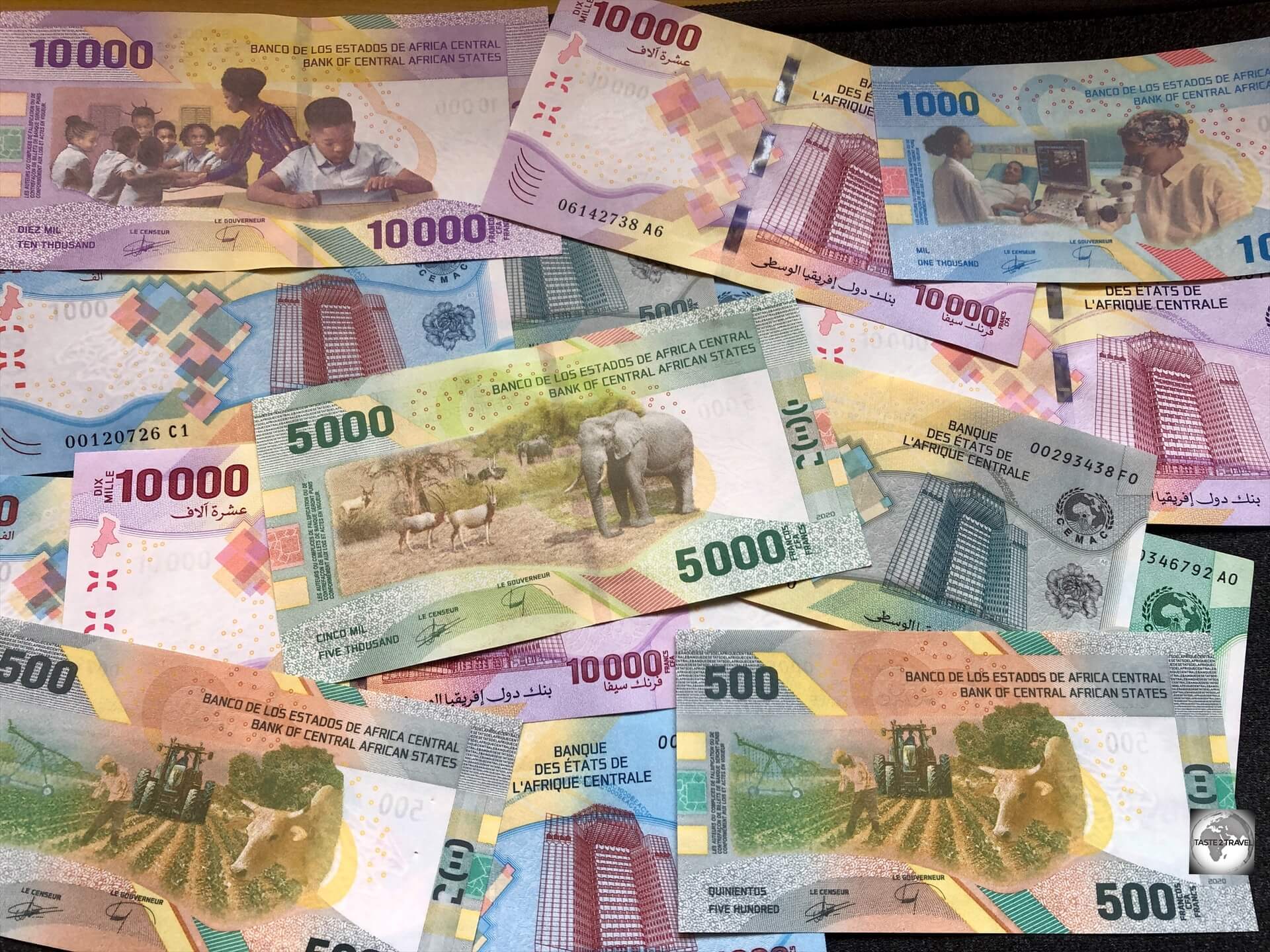
The currency of Equatorial Guinea is the Central African CFA franc, abbreviated as XAF.
Credit Cards
Like almost all other African countries, cash is king in Equatorial Guinea with credit cards rarely accepted.
It is advisable to have some local currency on hand for all transactions, as well as U.S. dollars or Euros for larger purchases or in case of emergencies.
ATMs
ATMs are available in major cities like Malabo and Bata, where you can withdraw cash using international debit or credit cards.
Like many other African countries, Visa card is widely accepted in ATMs while Mastercard is accepted by just a few banks – such as Eco bank and Société Générale.
Costs
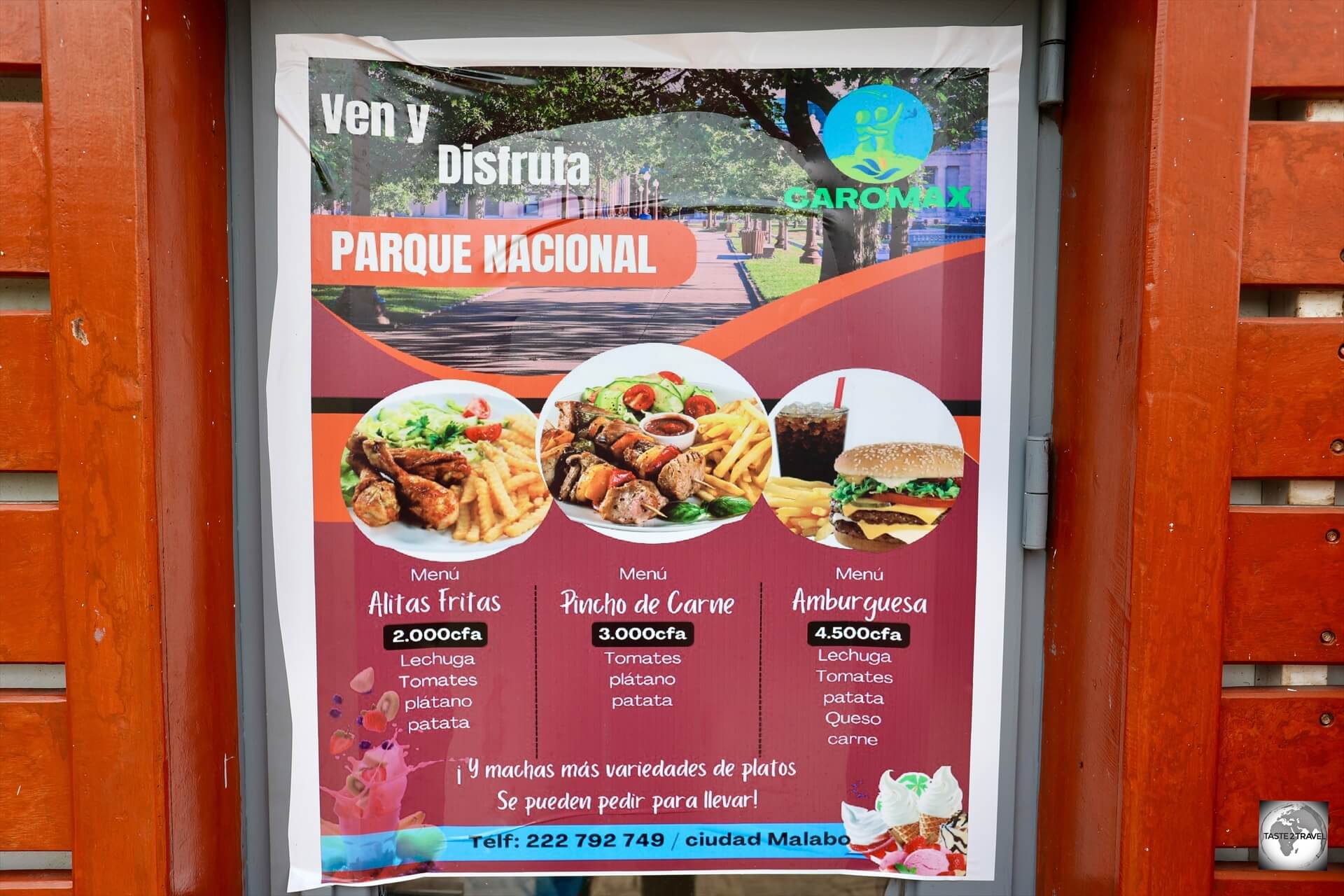
Menu prices, displayed at a café in the Malabo National Park.
Travel costs in Equatorial Guinea are typical of central African countries and of the CFA zone – i.e. higher than in other African countries.
This is not a budget-friendly destination for budget travellers.

The beer of choice in this former Spanish colony is San Miguel, which is brewed in Malaga, Spain.
Sample costs:
- Cappuccino at Café Malabo: CFA 2,000
- Bottle (.33l) of Coke/ Sprite: CFA 750
- Small bottled water: CFA 750
- Imported Beer (San Miguel): CFA 3,000
- Meal at an inexpensive café: CFA 2,000 – 4,000
- Meal at Café Malabo: CFA 5,000 – 10,000
- Standard hotel room (with breakfast) at the Ibis Malabo Hotel: €120
- Daytrip tour of Bioko Island with Rumbo Malabo: €285
WiFi

Despite being one of the wealthier countries in Africa, Equatorial Guinea has one of the slowest WiFi speeds in Africa.
The most frustrating thing you can do in Equatorial Guinea is to waste your time trying to use the incredibly slow internet.

WiFi speed test in Malabo which shows a typical download speed in Equatorial Guinea.
While the rest of the world measures WiFi speed in Mbps (megabits per second), in Equatorial Guinea, speed is still measured in kbps (kilobits per second).
Nowhere in the country did I experience anything faster than 512 kbps – i.e. the speed offered by an old-fashioned dial-up modem.
I performed internet speed tests in a number of locations, including at my hotel, and normally received download speeds of less than half a megabit per second (as indicated in the above screenshot).
An article on the Africa Report website states that downloading a 5GB movie took 734 minutes in the Republic of Congo, 788 minutes in Sao Tome, 850 minutes in Ethiopia, 965 minutes in Niger and 1,342 minutes in Equatorial Guinea.
There are various reasons for the slow internet speeds throughout Africa, including a lack of investment in infrastructure and also a desire by autocratic regimes (i.e. dictators) to hobble something which they consider to be a major threat to their hold on power.
Sightseeing

The Plaza of Equatorial Guinea is located on the Paseo Maritimo in Malabo.
Travel Authorisation
A special consideration for anyone wishing to venture beyond the capital of Malabo is the Travel Authorisation.
At police checkpoints around Bioko Island, you, or your tour company, will need to show this authorisation which is issued by the Department of Tourism and has a processing time of 3-4 days.
If you are travelling with a tour company, such as Rumbo Malabo, they can organise the authorisation in advance.
Malabo
The capital city of Equatorial Guinea, Malabo (pop: 297,000), is located on the northern coast of Bioko Island.
It’s a mix of Spanish colonial architecture and modern buildings.
While the government has built showpiece boulevards (especially connecting the new airport to downtown Malabo) which are lined with modern, glitzy office towers and ministry buildings, just behind this façade lies sprawling urban slums where many locals live in poverty.
St. Elizabeth’s Cathedral

St. Elizabeth’s Cathedral is a Roman Catholic cathedral located in the city of Malabo.
This beautiful Roman Catholic cathedral in Malabo is one of the city’s most iconic landmarks and a first stop on most sightseeing tours of the city.
Named after St. Elizabeth of Hungary, the cathedral is built in a neo-Gothic style that emphasises its façade, flanked by two 40-metre-high (130 ft) towers, and a nave with two aisles.

A view of the interior of St. Elizabeth’s Cathedral in Malabo.
Its construction began in 1897 with donations from parishioners, commercial companies and the Spanish government, for it was one of its colonies.
Designed by the architect, Luis Segarra Llairadó, the cathedral was inaugurated in 1916. The cathedral was seriously damaged by fire on January 16, 2020 while restoration work was underway. It has since been fully restored.

The copper doors at St. Elizabeth’s Cathedral in Malabo.
For those interesting in photographing the beautiful interior, the cathedral is normally closed during the day, but opens for mass which is conducted each day at 12 noon.

A view of the beautiful interior of St. Elizabeth’s Cathedral in Malabo.
This is the only time for photographing the interior and its best to arrive around 11:45 am, before mass commences.
Plaza of Independence

A view of the cathedral from Plaza of Independence, Malabo.
Opposite the cathedral, the Plaza of Independence (Plaza de la Independencia) contains traces of the long period of Spanish colonialism.
At the centre of the plaza stands a fountain, made of Carrara marble, with a Ceiba tree (a national symbol) at its centre.

A view of one of the ten tiled benches in the Plaza of Independence in Malabo.
Surrounding the fountain is a series of ten tiled benches and tiled pergolas. These have been recently renovated using not Spanish – but Italian – handmade tiles.
Malabo National Park

A view of Malabo National Park, which is a large manicured garden built by the Chinese.
Built by the China Road and Bridge Corporation, Malabo National Park is not a national park but a manicured garden, which features 8 different zones.
This new park is next door to the airport, and covers an area of 870,000 sq metres. The park offers restaurants, a sports area, activities for children, a lake with jet-skis and boats and an art gallery.

A statue of Teodoro Obiang Nguema Mbasogo, the president of Equatorial Guinea, at Malabo National Park.
As can be expected from a Chinese project, homage, in the form of a statue, is paid to the autocratic leader of Equatorial Guinea – Teodoro Obiang Nguema Mbasogo. The statue is installed just inside the main entrance gate.
The president is a former military officer who has served as the second president of Equatorial Guinea since 3 August 1979.
As of 2024, he is the second-longest consecutively serving current non-royal national leader in the world.

A very empty Malabo National Park provides an ideal retreat from bustling Malabo.
On the day of my visit, I was the only visitor in the park.
If you would rather not walk in the steamy tropical heat, you have the option to rent a bike and cycle around the park. There’s even a lake where you can rent a rowboat.

The sculpture plaza at Malabo National Park.
Of the eight zones – the Ethnic Customs Zone features a plaza lined with totem sculptures which depict local customs and beliefs.

Malabo National Park offers eight zones to explore plus a couple of cafes.
While the park is beautiful and pleasant to walk around, it’s somewhat soulless and surreal and reminded me of empty ‘showpiece’ parks in Turkmenistan!
Paseo Maritimo

A view along the Paseo Maritimo in Malabo.
Speaking of empty and soulless, the Paseo Maritimo is a wide paved Malecón which follows along the shore of the bay in Malabo.
Whenever I visited, I was the only one there!
There are a couple of empty cafés which serve meals and drinks.
Plaza of Equatorial Guinea

“I heart Guinea Equatorial” at the Plaza of Equatorial Guinea.
Installed at the centre of the Paseo Maritimo, the Plaza of Equatorial Guinea features the tallest flagpole in Malabo (with the smallest of flags fluttering somewhere at the top).
The (again empty) plaza features an “I heart Malabo” and “I heart Guinea Equatorial” signs.
Finca Sampaka

The driveway to Finca Sampaka is lined with towering palm trees.
Located on the southern outskirts of Malabo, Finca Sampaka is a cacao and coffee producing estate which dates from 1906.

Finca Sampaka was established on the outskirts of Malabo in 1906.
The name Sampaka is derived from the name of the original settler to the area, Samuel Parker, who emigrated from Liberia. The district in which the farm is located is called the Sampaka district.

Finca Sampaka export cacao and coffee beans around the world.
The farm, which has an area of about 1,000 hectares, is known for producing high quality cocoa and coffee.

The shop at Finca Sampaka, where you can purchase chocolate, coffee and even pepper, all of which is produced on the estate.
In the 1990s, the farm was incorporated into the CAMASA company who today produce high quality chocolate bars, coffee and even a local version of Nutella.

Cacao beans, in the processing laboratory at Finca Sampaka.
In the interest of research for this travel guide, I purchased a selection of chocolate products to sample. They were truly delicious!

Nothing beats the amazing aroma of freshly blended chocolate – seen here at Finca Sampaka.
Guided tours of the estate are available and should be booked through the Contact page of the company website.

The CAMASA company produce high quality chocolate bars, coffee and even a local version of Nutella.
One of their most versatile products is their Crema de Cacao which is a local version of Nutella and, as per the label, can be enjoyed on bread, with deserts and even with fruits. Nice!

Coffee beans for sale at Finca Sampaka.
While chocolate is the mainstay of the farm, they also have a coffee tree plantation which produces very flavourful beans, which can be purchased at the farm shop.
Accommodation
Malabo
Ibis Malabo

Suffering issues with dampness, the Ibis Malabo Hotel has been under renovation for more than one year, with the external cladding slowly being replaced.
Thanks to the many visiting oil and gas executives, Malabo is blessed with a good selection of hotels – most of which cater to visiting business travellers with hefty travel budgets!

My spacious and comfortable room at the Ibis Malabo Hotel.
During my time in Malabo, I stayed at the very nice Ibis Malabo Hotel.
Room rates start at €110 for a standard room without breakfast. Since there are no restaurants or cafes nearby, it’s best to add breakfast which is an additional €10.
The hotel, which suffers from issues relating to dampness, has been under renovation for more than a year, with its exterior cladding being replaced.

My spacious and comfortable room at the Ibis Malabo Hotel.
Like many hotels in Malabo, the Ibis is located in the middle of nowhere, surrounded by a few government ministry buildings and lots of green parkland.
To travel anywhere, you will need transport or you’ll need to flag a shared taxi from the road. A trip into the downtown area costs CFA 1,000,

All rooms feature the standard Ibis pod-bathroom.
Due to its isolated location, most guests tend to eat dinner in the hotel restaurant.
During my stay the hotel was empty so the restaurant most nights was empty.

The pool at the Ibis Malabo, which was never used.
The hotel features a pool and a large green garden but this too was always empty.
Eating Out
Malabo
Cafe Malabo

Located in the heart of Malabo, the comfortable and inviting Café Malabo serves good coffee and excellent food.
The standout restaurant in the downtown area is the comfortable and inviting Café Malabo which is the preferred venue for locals, ex-pats and any tourists which have ventured to this remote corner of the world.

Café Malabo serves as a cafe, restaurant, winery and a concert space for local performers.
Cafe Malabo is open for breakfast, lunch and dinner and serves a variety of international (with an emphasis on Spanish) and local dishes.

Another excellent Café con leche at Café Malabo.
Apart from its excellent cafe offerings, Café Malabo serves as a restaurant, winery and a concert space for local performers.
Visa Requirements

My immigration entry and exit stamps for Equatorial Guinea.
In the past, obtaining a visa to visit Equatorial Guinea was notoriously difficult.
However, this has now changed thanks to a change in policy by the Government of Equatorial Guinea who has implemented a policy of economic diversification as a result of falling oil revenues, the main source of income for the Equatorial Guinean economy.
Within the framework of this diversification of the economy, the tourism sector plays an important role.
To help boost tourist arrivals, a new eVisa website has been created which now allows visitors to apply online for a visa, which is usually granted, without fuss, in five business days.
Never has there been an easier time to visit Equatorial Guinea!
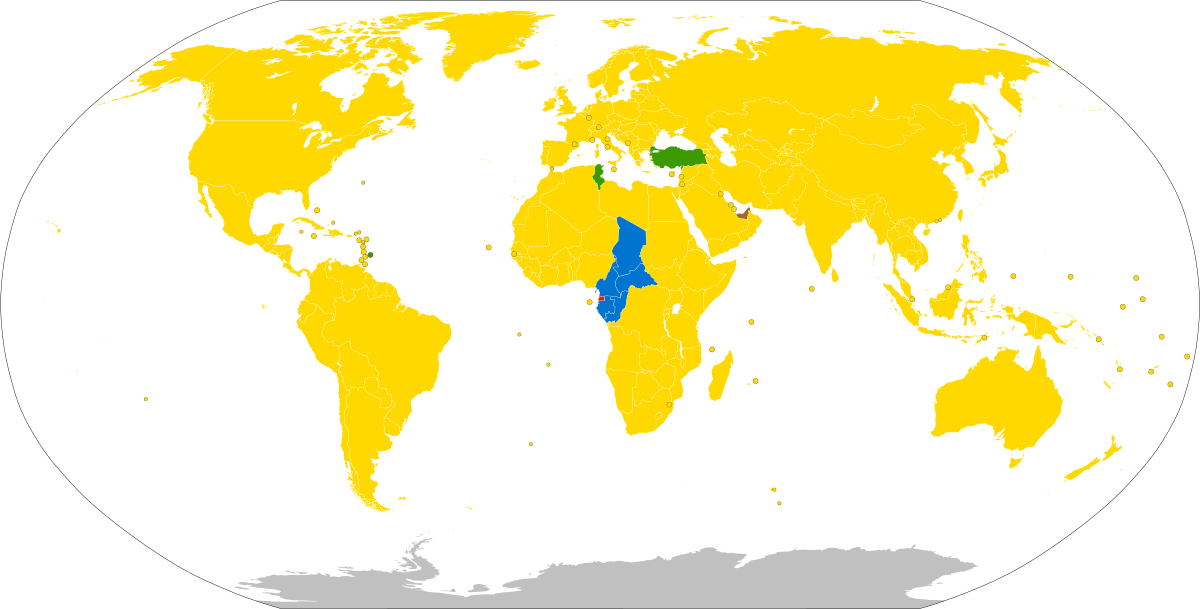
The Visa Policy map of Equatorial Guinea.
Source: Wikipedia.
The Visa Policy of Equatorial Guinea is very simple – almost everyone needs to obtain a visa in advance!
eVisa Process

A copy of my eVisa for Equatorial Guinea.
Applications for an eVisa for Equatorial Guinea, must be made at the eVisa website which was developed by VFS global, a Swiss company. As can be expected from anything created by the Swiss, the website functions very efficiently.
the application process is very straight-forward and will require you to upload the following:
- A scan of the photo page of your passport.
- A return flight ticket (all eVisa holders must arrive at Malabo International Airport). Note: your visa will be made valid for the dates of your flights only.
- A confirmed hotel reservation covering all the nights of your stay in the country.
Finally, you must pay, online, the processing fee of US$75 which is non-refundable.

A copy of my eVisa payment receipt.
Once submitted, you will receive a receipt via email (as shown above).
After a processing time of 5-days you should receive your eVisa via email. This should be printed and presented upon arrival at Malabo International Airport.
When you arrive at Malabo airport, you will be simply stamped into and out of the country.
You will not receive a full-page visa in your passport.
Getting There

Departure board at Malabo International Airport.
Air
Malabo Airport
All international flights arrive at Malabo International Airport, or Saint Isabel Airport, (IATA: SSG) which is located on the island of Bioko. The airport is located 9 kilometres (5.6 mi) to the east of Malabo.
All eVisa holders must arrive at Malabo International Airport.
If you are arriving from a neighbouring African country, you can’t help but be impressed by the new modern, shiny terminal building with its 6 air-bridges which was built by a Chinese company, ABC Construcciones WEI.
Although there is plenty of retail space allocated inside the terminal, there are currently no shops and no cafes at the airport. You should bring any food and drinks you might need prior to your flight.
The airport is the hub for two national carriers; CEIBA Intercontinental and Cronos Airlines who operate shuttles across to Bata.
The following airlines operate scheduled services to/from Malabo Airport:
- Afrijet – flies to/ from Libreville
- Air France – flies to/ from Douala, Paris–Charles de Gaulle
- CEIBA Intercontinental – flies to/ from Bata, Cotonou, Lomé, Mengomeyén
- Cronos Airlines – flies to/ from Bata, Cotonou, Douala, Port Harcourt
- Ethiopian Airlines – flies to/ from Addis Ababa, Douala
- Lufthansa – flies to/ from Frankfurt, Lagos
- Plus Ultra Líneas Aéreas – flies to/ from Madrid
- Royal Air Maroc – flies to/ from Casablanca, Libreville
- Turkish Airlines – flies to/ from Istanbul, Port Harcourt
Airport Transport
Most hotels on Malabo offer airport shuttle services.
Taxis meet all flights at Malabo Airport with a ride into downtown costing CFA 2,000!
Bata Airport
Located on the mainland, Bata Airport is served by a couple of local airlines which connect Bata Airport to Malabo Airport.
The following airlines operate scheduled services to/from Bata Airport:
Getting Around

A view of the main boulevard which connects Malabo airport to downtown Malabo.
Public Transport
Public transport is in the form of overcrowded mini-buses or shared taxis.
The cost of a place in a shared taxi is CFA 1,000 for anywhere in downtown Malabo.
That’s the end of my Equatorial Guinea Travel Guide.
If you wish to leave a comment or provide feedback, you can do so using the form below or via the Contact page.
Safe Travels!
Darren





